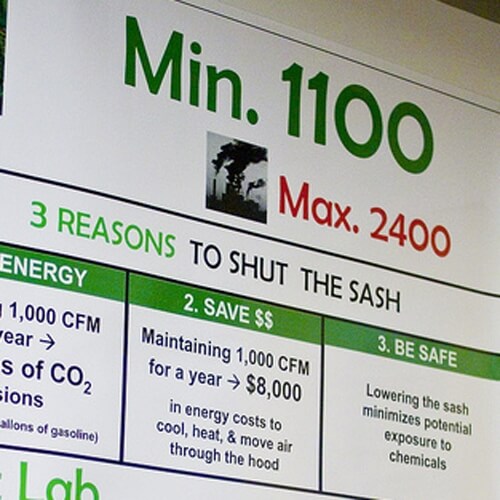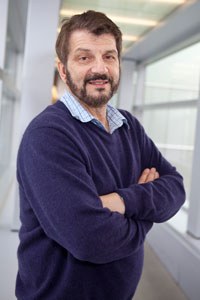News
A sign in the Weitz lab reminds researchers to use equipment safely and efficiently. Below this sign, an LED display shows the current power usage for the variable fume hood.
Planning an environmentally conscious laboratory move and renovation required the close collaboration of graduate students Tom Kodger (left) and Donald Aubrecht (right), Professor David Weitz (center), Capital Project Manager Pamela Choi Redfern (front left), and Facilities Manager Donald Claflin (front right).
Cambridge, Mass. - April 11, 2011 - With Earth Day just around the corner and young leaves peeping out of their buds, reminders to think "green" are all around.
The nominations for Harvard's annual Green Carpet Awards (April 11) highlight a few of the projects taking place at the School of Engineering and Applied Sciences (SEAS) that are helping to keep the campus community aware of its impact on the environment.
Far from simply lighting offices and heating classrooms, SEAS houses and supports laser labs, imaging suites, and powerful computing facilities. Resources such as these are critical for research that will define the future of science, technology, and society.
Finding ways to make everyday operations energy-efficient and sustainable is not just a priority, but an imperative at SEAS and across the University. That shift in culture relies on changes to infrastructure and planning at the institutional level, but also on individual commitments to changing behavior on a daily basis.
Laboratory improvements
David Weitz, Mallinckrodt Professor of Physics and Applied Physics, and his research group in the Experimental Soft Condensed Matter Lab have been nominated for a Green Carpet Award for their dedication to sustainable practices in the laboratory.
Weitz's 58-member lab group—the largest at SEAS and one of the largest in all of FAS—made a deliberate and sophisticated effort to minimize the environmental impact of their recent move from the Engineering Sciences Laboratory building into a new space in the 56-year-old Gordon McKay Laboratory on Oxford Street.
Graduate students Tom Kodger and Donald Aubrecht worked closely with the facilities and planning administration to design an environmentally friendly laboratory and office environment that met the unique needs of this lab group.
During the transition, the planning team followed LEED green building guidelines set by the U.S. Green Building Council, installed new, energy-efficient ventilation systems, and reused or donated all of the furniture and equipment from the previous Weitz lab location.
More than 30 banker's boxes of partially used lab supplies such as glassware, as well as an acid storage cabinet, were donated to other, smaller labs in SEAS and in the departments of Molecular and Cellular Biology and Organismic and Evolutionary Biology.
Weitz's lab group even donated sections of chemical-resistant counter tops to a K-8 school in New York state.
"This quality of countertop was beyond the budget of what the school could have afforded for its chemistry lab, so they were thrilled to receive the gift," says Weitz.
To maximize energy efficiency, the layout of the lab was designed to let in as much natural light as possible—which can be difficult while accommodating large pieces of equipment—and the artificial lighting systems are controlled by motion sensing dimmers.
Most importantly, the new lab incorporates variable fume hoods with exhaust flow monitoring, which means that they will no longer be "always on." New air handlers that are compatible with this system have been installed on the roof, and as other labs in the McKay building undergo remodeling, they will be set up with the newer fume hoods.
"This project was successful at meeting all of the group's needs and incorporating the sustainability goals because of the close collaboration between the architectural and engineering planning team and the end users," says Capital Project Manager Pamela Choi Redfern.
Facilities Manager Donald Claflin adds: "Because this is such a large and prolific lab group, the careful choices they made during the design and renovation of this lab space will have far-reaching environmental benefits, not just in terms of the decreased consumption of utilities and reuse of materials, but also in individual behavioral changes motivated by working in a sustainable environment."
If the new Weitz lab achieves LEED Gold Certification as planned, it will be the first "officially green" lab in McKay, and, administrators hope, the first of many in that building.
Going for "Gold"—the IT Office
SEAS received its first LEED Certification last year (the 38th for Harvard overall), for the 2009 renovation of the Computing and Information Technology (IT) Office in Maxwell Dworkin.
That project converted 2,003 square feet of lounge space intoeight office areas to accommodate the IT staff and services. The renovation required the installation of new furnishings, lighting, windows, millwork, and electrical, tel-data, and audiovisual systems.
In the planning stages and throughout construction, the process of identifying sustainable materials and efficient utility systems was guided by the Harvard Green Building Standards and the LEED Commercial Interiors rating system.
Of the total material in the new IT office, 56 percent by cost consists of products that were manufactured within 500 miles of the project site, and 28 percent was recycled content. All of the composite wood used was urea formaldehyde-free.
When the project was complete, 84 percent of the construction and demolition waste was diverted from landfills.
Additionally, through the selection and strategic placement of energy-efficient and low-mercury fluorescent lamps, the overall lighting power density now showsa 15 percent reduction below code.
Green thumbs and green thinking
Individual efforts at SEAS also contribute to a culture of environmental awareness and incremental change.
Custodian Joanne Carson has been nominated for a Green Carpet Award for creating a program that recycles used coffee grounds from the heavily trafficked Pierce Hall kitchen. Carson promotes alternative uses for the leftover coffee (e.g., as a nitrogen-rich plant fertilizer), packages it for faculty and staff to take home, and coordinates weekly deliveries.
"Sometimes a barrier to participating in greater community sustainability efforts is lack of awareness or even lack of coordination. Joanne has been able to reach our entire community and helped raise our collective consciousness around green behavior," says Jennifer Casasanto, Administrative Director at SEAS.
Matthew Hayek, a graduate student in the Wofsy-Munger Group on Biosphere-Atmosphere Exchange, has also been nominated for both his research on climate change and his involvement in the Student Sustainability Advisory Group (SAG) at Harvard. Student members of SAG work closely with the University administration to help it meet its long-term sustainability goals.
The winners of the 2011 Harvard Green Carpet Awards will be announced at a special ceremony on Monday, April 11, in Sanders Theatre in Memorial Hall, from 3:30 to 5:00 p.m.
Cutting-edge science delivered direct to your inbox.
Join the Harvard SEAS mailing list.
Scientist Profiles
Pamela Choi Redfern
Associate Dean for Campus Planning and Design
David A. Weitz
Mallinckrodt Professor of Physics and of Applied Physics

